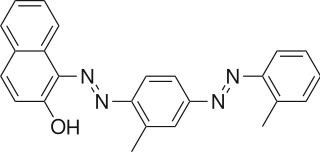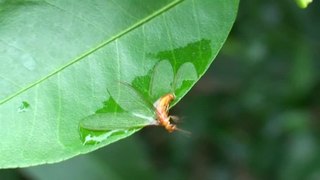Related Research Articles

Blood alcohol content (BAC), also called blood alcohol concentration or blood alcohol level, is a measurement of alcohol intoxication used for legal or medical purposes; it is expressed as mass of alcohol per volume of blood. For example, a BAC of 0.10 means that there is 0.10 g of alcohol for every 100 mL of blood. A BAC of 0.0 is sober. In different countries the maximum permitted BAC when driving ranges from the limit of detection to 0.08%. BAC levels over 0.08% are considered impaired; above 0.40% is potentially fatal.

Ethanol is an organic compound with the chemical formula CH3CH2OH. It is an alcohol, with its formula also written as C2H5OH, C2H6O or EtOH, where Et stands for ethyl. Ethanol is a volatile, flammable, colorless liquid with a characteristic wine-like odor and pungent taste. It is a psychoactive recreational drug, and the active ingredient in alcoholic drinks.
An emulsion is a mixture of two or more liquids that are normally immiscible owing to liquid-liquid phase separation. Emulsions are part of a more general class of two-phase systems of matter called colloids. Although the terms colloid and emulsion are sometimes used interchangeably, emulsion should be used when both phases, dispersed and continuous, are liquids. In an emulsion, one liquid is dispersed in the other. Examples of emulsions include vinaigrettes, homogenized milk, liquid biomolecular condensates, and some cutting fluids for metal working.

Alcohol proof is a measure of the content of ethanol (alcohol) in an alcoholic beverage. The term was originally used in England and from 1816 was equal to about 1.75 times the percentage of alcohol by volume (ABV). The United Kingdom today uses ABV instead of proof. In the United States, alcohol proof is defined as twice the percentage of ABV. The definition of proof in terms of ABV varies from country to country.

The collodion process is an early photographic process. The collodion process, mostly synonymous with the "collodion wet plate process", requires the photographic material to be coated, sensitized, exposed, and developed within the span of about fifteen minutes, necessitating a portable darkroom for use in the field. Collodion is normally used in its wet form, but it can also be used in its dry form, at the cost of greatly increased exposure time. The increased exposure time made the dry form unsuitable for the usual portraiture work of most professional photographers of the 19th century. The use of the dry form was mostly confined to landscape photography and other special applications where minutes-long exposure times were tolerable.

Collodion is a flammable, syrupy solution of nitrocellulose in ether and alcohol. There are two basic types: flexible and non-flexible. The flexible type is often used as a surgical dressing or to hold dressings in place. When painted on the skin, collodion dries to form a flexible nitrocellulose film. While it is initially colorless, it discolors over time. Non-flexible collodion is often used in theatrical make-up. Collodion was also the basis of most wet-plate photography until it was superseded by modern gelatin emulsions.

Fractional freezing is a process used in process engineering and chemistry to separate substances with different melting points. It can be done by partial melting of a solid, for example in zone refining of silicon or metals, or by partial crystallization of a liquid, as in freeze distillation, also called normal freezing or progressive freezing. The initial sample is thus fractionated.

Steatosis, also called fatty change, is abnormal retention of fat (lipids) within a cell or organ. Steatosis most often affects the liver – the primary organ of lipid metabolism – where the condition is commonly referred to as fatty liver disease. Steatosis can also occur in other organs, including the kidneys, heart, and muscle. When the term is not further specified, it is assumed to refer to the liver.
Biodiesel production is the process of producing the biofuel, biodiesel, through the chemical reactions of transesterification and esterification. This involves vegetable or animal fats and oils being reacted with short-chain alcohols. The alcohols used should be of low molecular weight. Ethanol is the most used because of its low cost, however, greater conversions into biodiesel can be reached using methanol. Although the transesterification reaction can be catalyzed by either acids or bases, the base-catalyzed reaction is more common. This path has lower reaction times and catalyst cost than those acid catalysis. However, alkaline catalysis has the disadvantage of high sensitivity to both water and free fatty acids present in the oils. August 10 is international biodiesel day

Kilju is the Finnish word for home made alcoholic beverage typically made of sugar, yeast, and water.

A breathalyzer or breathalyser is a device for measuring breath alcohol content (BrAC). The name is a genericized trademark of the Breathalyzer brand name of instruments developed by inventor Robert Frank Borkenstein in the 1950s.

Sudan IV (C24H20N4O) is a lysochrome (fat-soluble dye) diazo dye used for the staining of lipids, triglycerides and lipoproteins on frozen paraffin sections. It has the appearance of reddish brown crystals with melting point 199 °C and maximum absorption at 520(357) nm.
Osmol gap in medical science is the difference between measured serum osmolality and calculated serum osmolality.

An amphiphile, or amphipath, is a chemical compound possessing both hydrophilic and lipophilic (fat-loving) properties. Such a compound is called amphiphilic or amphipathic. Amphiphilic compounds include surfactants. The phospholipid amphiphiles are the major structural component of cell membranes.

Acid guanidinium thiocyanate-phenol-chloroform extraction is a liquid–liquid extraction technique in biochemistry. It is widely used in molecular biology for isolating RNA. This method may take longer than a column-based system such as the silica-based purification, but has higher purity and the advantage of high recovery of RNA: an RNA column is typically unsuitable for purification of short RNA species, such as siRNA, miRNA, gRNA and tRNA.

Miscibility is the property of two substances to mix in all proportions, forming a homogeneous mixture. The term is most often applied to liquids but also applies to solids and gases. An example in liquids is the miscibility of water and ethanol as they mix in all proportions.

The ouzo effect, also known as the louche effect and spontaneous emulsification, is the phenomenon of formation of a milky oil-in-water emulsion when water is added to ouzo and other anise-flavored liqueurs and spirits, such as pastis, rakı, arak, sambuca and absinthe. Such emulsions occur with only minimal mixing and are highly stable.
Isopropyl alcohol is a colorless, flammable organic compound with a pungent alcoholic odor. As an isopropyl group linked to a hydroxyl group it is the simplest example of a secondary alcohol, where the alcohol carbon atom is attached to two other carbon atoms. It is a structural isomer of propan-1-ol and ethyl methyl ether. They all have the formula C3H8O.

A hydrophile is a molecule or other molecular entity that is attracted to water molecules and tends to be dissolved by water.

Phosphatidylethanols (PEth) are a group of phospholipids formed only in the presence of ethanol via the action of phospholipase D (PLD). It accumulates in blood and is removed slowly, making it a useful biomarker for alcohol consumption. PEth is also thought to contribute to the symptoms of alcohol intoxication.
References
- ↑ Rothery, Mark. "Techniques: Biochemical Tests". Mark Rothery's Biology Web Site.